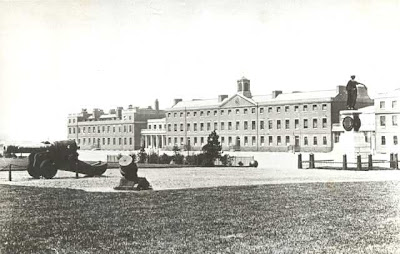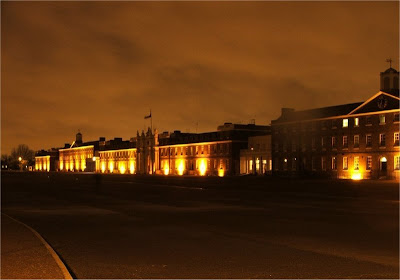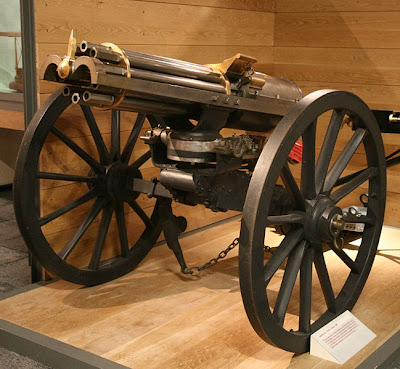 Early picture of Woolwich Barracks, built in 1775. An artilleryman's basic training when I was here in 1979 was about 16 weeks in length, about 8-9 weeks basic infantry training followed by basic gunnery training on 105mm light field guns. After passing out and being assigned to a unit, training continued in your unit.
Early picture of Woolwich Barracks, built in 1775. An artilleryman's basic training when I was here in 1979 was about 16 weeks in length, about 8-9 weeks basic infantry training followed by basic gunnery training on 105mm light field guns. After passing out and being assigned to a unit, training continued in your unit. The Royal Artillery Barracks at Woolwich circa 1900. The principle training centre for many years for budding artillerymen. Larkhill on Salisbury plain has taken over as the key training facility for the artillery. Metal from one of the cannons lining the "South Parade" is used in the production of "Victoria Crosses", by all accounts the metal is not the best of quality and is a bit of a pig to work with when making the medals.
The Royal Artillery Barracks at Woolwich circa 1900. The principle training centre for many years for budding artillerymen. Larkhill on Salisbury plain has taken over as the key training facility for the artillery. Metal from one of the cannons lining the "South Parade" is used in the production of "Victoria Crosses", by all accounts the metal is not the best of quality and is a bit of a pig to work with when making the medals. The Royal Artillery Barracks today, not a huge amount appears to have change in the last hundred years. Its a massive area running the entire length at the front of the barracks which forms "South Parade" the main parade ground, and it was an eternity that we seemed to be out there in the baking sunshine during our passing out parade. I think some were thinking they would be passing out literally. Earmarked as a venue in the 2012 Olympics.
The Royal Artillery Barracks today, not a huge amount appears to have change in the last hundred years. Its a massive area running the entire length at the front of the barracks which forms "South Parade" the main parade ground, and it was an eternity that we seemed to be out there in the baking sunshine during our passing out parade. I think some were thinking they would be passing out literally. Earmarked as a venue in the 2012 Olympics. The Royal Artillery Barracks at night. Not that we had much time to appreciate such sights, hours of spit and polish every night, ironing kit, etc, etc. Also to get out of the barracks at night, recruits had to achieve one important task which was "passing off the square". This meant that recruits had to reach a satisfactory level in drill practice to obtain a pass off camp, this could easily take a number of weeks with 3-4 being common. Some could take longer, but the accolade of "passing off the square" was a milestone in basic training for recuits.
The Royal Artillery Barracks at night. Not that we had much time to appreciate such sights, hours of spit and polish every night, ironing kit, etc, etc. Also to get out of the barracks at night, recruits had to achieve one important task which was "passing off the square". This meant that recruits had to reach a satisfactory level in drill practice to obtain a pass off camp, this could easily take a number of weeks with 3-4 being common. Some could take longer, but the accolade of "passing off the square" was a milestone in basic training for recuits. Officer mess at Woolwich Barracks. This was a place were recruits could earn a few extra quid working in the capacity of waiters when there were special events of diners on.
Officer mess at Woolwich Barracks. This was a place were recruits could earn a few extra quid working in the capacity of waiters when there were special events of diners on. The Old Gatehouse of Woolwich Royal Arsenal, the Woolwich Royal Arsenal was an important installation for the manufacture of armaments and munition for over 200 years.
The Old Gatehouse of Woolwich Royal Arsenal, the Woolwich Royal Arsenal was an important installation for the manufacture of armaments and munition for over 200 years. One of the exhibit at the artillery museum at Woolwich is the Gatling gun. At the time when I was there, the collection was entirely housed in the Rotunda, now the bulk of the collection is housed in a purpose built facility a Woolwich docks.
One of the exhibit at the artillery museum at Woolwich is the Gatling gun. At the time when I was there, the collection was entirely housed in the Rotunda, now the bulk of the collection is housed in a purpose built facility a Woolwich docks. One of the exhibit at the artillery museum at Woolwich is the 3.7 inch mountain gun. Certainly look a good bit lighter than what we had to train on. Gunnery training at Woolwich was done using the 105mm light field gun, a versatile piece of ordnance weighing about 2 tonnes. I remember one unpleasant episode in gunnery training, we were split into groups of six and we had a chap called "Evans". He was a likable enough bloke, but he had a bad trait which was that if misfortune befell anyone, it was nine times out of ten his lot to be the recipient of such misfortune. One day we had to practice the art of stripping the breech block from the 105, the trainee would be one side of the breech while the gunnery instructor would be on the other side.
One of the exhibit at the artillery museum at Woolwich is the 3.7 inch mountain gun. Certainly look a good bit lighter than what we had to train on. Gunnery training at Woolwich was done using the 105mm light field gun, a versatile piece of ordnance weighing about 2 tonnes. I remember one unpleasant episode in gunnery training, we were split into groups of six and we had a chap called "Evans". He was a likable enough bloke, but he had a bad trait which was that if misfortune befell anyone, it was nine times out of ten his lot to be the recipient of such misfortune. One day we had to practice the art of stripping the breech block from the 105, the trainee would be one side of the breech while the gunnery instructor would be on the other side.We had to run through process of extract the breech block from the gun and then replacing. When "Evans" turn came he did alright up until when he was putting the breech block back in, some how he let go of it and it passed right through the breech and out of the bottom eventually making contact with one of the of the toe caps of the instructor's boots. Fortunately they were steel toe capped boots, but the mirror finish on them was unrepairable. To say you could have heard a pin drop in the silence that followed would have been an understatement. There were six hearts filled with dread of the pending retribution that this stroke of misfortune would bring down on our heads. We six had to drag one of the 105's all the way around Woolwich common, a distance all the way round of about two miles, and the pace was far from being slack. Any slacking that was detected immediately provoked a size 11 hobnail as a form of encouragement, we completed the two odd miles, two miles that none of us would ever forget in our lives. Needless to say "Evans" got it right the next time he had to perform this task, which was a relief to everyone else.
 One of the exhibits at the artillery museum at Woolwich, an FV433 Abbot self propelled gun.
One of the exhibits at the artillery museum at Woolwich, an FV433 Abbot self propelled gun.
Anyone has contact info on sgt stoddart colenso troop era 1979
ReplyDeletePlease whatsapp me at new York 516-6439302